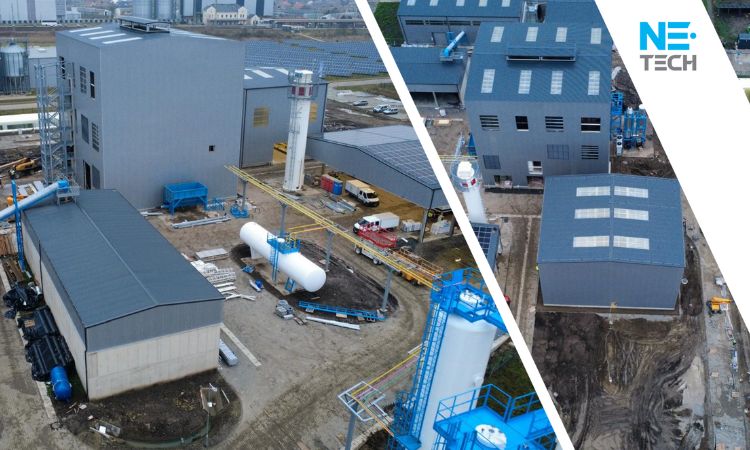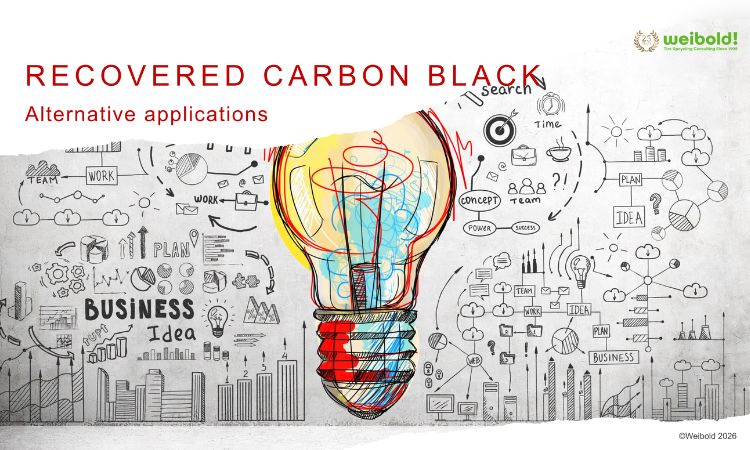Weibold Academy: Pyrolysis oils as raw material components for steam crackers
Weibold Academy article series discusses periodically the practical developments and scientific research findings in the end-of-life tire (ELT) recycling and pyrolysis industry.
This article is a review by Dr. Pavol Fehér – senior pyrolysis consultant at Weibold. Pavol Fehér used to work on R&D projects at Slovnaft Refinery and MOL Group, where he researched treatment feasibility of waste materials, particularly waste tires, and plastics, and worked with technologies designed to improve pyrolysis fuels. Mr. Fehér possesses over 40 years of experience at oil refinery and in the petrochemical industry.
One of the goals of this review is to give entrepreneurs in this industry, project initiators, investors and the public, a better insight into a rapidly growing circular economy. At the same time, this article series should also be a stimulus for discussion.
For the sake of completeness, we would like to emphasize that these articles are no legal advice from Weibold or the author. For legally binding statements, please refer to the responsible authorities and / or specialist lawyers.
Introduction
Decarbonizing the industrial sector including waste treatment is one of our great challenges. Decarbonisation is needed at greater speed and scale if companies are to remain compliant, viable and profitable. But deciding which pathways to adopt can be challenging. One of the main challenges is the trilemma of energy needing to be secure, affordable, and low carbon. These parameters need to be managed in unison, despite the volatility in prices, policy and supply.
As part of the newest R&D initiatives, refinery and waste material valorisation experts are developing, implementing, and sharing technologies and best practices in close collaboration in order to produce value-added products, increase energy efficiency and reduce greenhouse gas emissions in manufacturing plants and other industrial facilities. Europe´s downstream industry is playing a leading role and guaranteeing the obtained products’ quality and performance properties.
This article summarizes olefin production via the steam cracking process and aims to provide insights into integrated decarbonization and sustainability value chains. These value chains are typical for obtaining a raw material portfolio component like pyrolysis oil from tire and plastic waste treatment for steam cracking units. Thus, the focus is on feasibility of fossil substituting raw material with alternatives from waste treatment and reformulating feedstock composition, with the goal of improving the obtained products’ quality, emissions and mechanical/application properties as well as on identifying the major gaps in knowledge and needs for further assessments.
Status of the technology
Light olefins are the main building blocks used in the petrochemical and chemical industries to produce different components such as polymers, synthetic fibres, rubbers, and plastic materials. Different technologies have been used to produce light olefins using various feedstocks, such as crude oil, natural gas, coal, and biomass. The main technologies for producing light Olefins are steam cracking (SC) and fluid catalytic cracking (FCC). Heavier Olefins are produced by different process technologies.
Steam crackers play a central role in the production of basic chemicals and require a significant amount of energy to break down hydrocarbons into olefins and aromatics.
Numerous recent studies document the ongoing intense effort to reduce the operational expenses and to increase the material and energy/exergy efficiency of ethylene plants by optimizing the feedstock composition, reactor designs, back-end separation sections, and the energy structure. [ref. 1-6]. It was found that a significant increase in a steam cracker unit´s profits and savings in CO2, NOx and SO2 emissions can be achieved by optimizing the feedstock’s chemical composition to a multi-objective standard calculated for the investigated production unit.
The effect of (various) feedstock composition
Various studies have shown that the profitability of steam cracker unit depends on several factors including feedstock cost, yield rate, product type, and facility scale. Feedstock composition, pyrolysis yield, and product selectivity are critical drivers for process efficiency. Feedstock cost, capital investment, and market prices play a significant role in the profitability of a pyrolysis installation at the steam cracker units.
In general, by changing the feedstock from ethane to propane and butane and liquid feedstocks, the ethylene yield decreased by more than 40%, whereas the yield of heavier olefins increased.
Steam cracking (SC) of naphtha fractions resulted in higher yields of ethylene and propylene (36%) than the yields of the same products obtained from the steam cracking of wide-range gas oil (28.3%). However, the yields of pyrolysis fuel oil (pyro-oil) and pyrolysis gasoline (pygas) is higher when some gas oil is used as the feedstock. [ref. 6]
It is well-known that pygas is a by-product of the steam cracking process. Its yield is few percent from ethane SC, in the order of 20% from naphtha SC and 30% from gasoil SC. It contains around 60 % wt. of aromatics.
Current tire- and plastic waste-derived pyrolysis oils exceed typical industrial steam cracker feedstock specifications and are therefore upgraded (at the off-taker’s side), with hydrogen-based technologies being the most effective.
Solid waste-derived pyrolysis oils as steam cracking feedstocks are evaluated based on their chemical composition. The most flexible and powerful analytical tool is a two-dimensional gas chromatography (GC × GC) coupled to various detectors. The first column separation is typically based on a non-polar stationary phase whereas the shorter and narrower second column separates the effluent compounds based on polarity. GC × GC is especially interesting for samples consisting of both well-known compound families such as paraffins, olefins, naphthenes or aromatics and a high number of isomers and homologues.
The latest pilot-scale and large-scale findings proved that the C to H effective ratio (H/Ceff ratio) calculated based elementary composition (content of H, C, O, N, Cl) of the raw material can be used to predict the yield of valuable pyrolysis products (BTX+Olefins+Paraffins). In general, the higher the H/Ceff ratio, the higher the product yield.
Moreover, a synergism was found, because heteroatoms present in steam cracker´s raw materials have positive impact on the C1-4 product yields and emissions because hydrogen reacts with oxygen to make water, hydrogen combines with nitrogen to make nitriles and ammonia, and hydrogen reacts with chlorine to make hydrochloric acid.
Reformulating the raw material composition for steam cracker units
Given the enormous scale of operation for commercial steam crackers and the fact that economic penalties such as carbon taxes are being introduced, there is a huge potential for using pyrolysis oils as feedstocks for already existing steam cracker units.
One of the main points to be still defined is the best raw materials for steam cracker units.
Process simulation tools are needed for optimizing the raw material composition. Considering that high-purity olefins are necessary for maximum conversion of polymerisation reactions, selective hydrogenation is crucial for purifying olefinic streams into highly differentiated products.
Quite a different approach must be taken when the production of chemicals is taken into consideration. Two-stage hydrogenation of pygas prepares the stream for the C₈-C₉ aromatics complex, while installation of a fractionator between the 1st and 2nd stage of the pygas hydrogenation unit can also provide marketable low-sulphur gasoline, diesel and fuel oil quality volumes from olefins-rich raw material-based steam crackers.
The monocyclic aromatic hydrocarbons (BTEX and styrene, as well as several other compounds) represent key intermediates in petrochemistry. Their production is necessary for the manufacture of many final products which have become unavoidable in our life, such as pharmaceuticals, detergents, cosmetics, plastics, rubbers, etc. In a global energy transition to renewables, the need for such chemical intermediates will remain the same or is forecast to even grow. [ref. 8]
While edible matter is to be excluded for future advanced fuels production, the use of oil from plastic and end-of-life tires represents a very interesting approach. As the composition of these waste materials is variable, a close cooperation of refinery and waste treatment experts and the use of refinery engineering to produce petroleum-like liquids with the best properties for SC pyrolysis unit could help in finding optimal solutions.
As mentioned above, cost-effective optimization and scaling of refinery & waste treatment technologies are needed due to gas shortages, high gas and electricity prices in Europe and strict industrial emission limits set up by RED III directive.
Optimizing energy consumption and process features including emissions by using various pyrolysis oils in steam cracker plants is needed. It is a promising means of achieving EU material and energy efficiency improvement goals. However, as yet, there are no relevant studies in the field of SC energy management optimization that employ field data and address other major pollutants when using pyrolysis oils in steam cracker´s feedstocks.
Conclusion
Petrochemical producers have recently confronted unprecedented volatility in crude oil prices and limits on advantaged feedstock, while the refining and gas sectors have to remain vigilant in monitoring global supply conditions. There is a need to optimize plant operations and cut emissions and carbon footprint by reducing the amount of energy required to drive a plant.
We are now facing a likely revolution, with a forecasted enormous growth of the production of electrical energy using renewable sources (mainly eolic and photovoltaic), and this also will increase the need for optimizing refinery raw materials compositions and developing new petrochemical processing technologies.
Latest R&D results and practises proved that the use of tire derived pyrolysis oils (TDO) as a raw material component for steam cracking unit will be the best choice still for several years at least in some fields (e.g., polyolefins and other products production poor in aromatics or aromatics-rich solvents). This pushes to the development of new components for SC feed.
Innovative technology geared towards reformulating raw material compositions and reducing emissions and energy consumption in steam cracking furnaces provides an important solution to the chemical industry.
Governments and leaders have set out ambitious targets with the eventual goal to achieve net zero. Overall, the industry has yet to adjust to this change as only a few large companies in the energy sector have taken up this challenge by outlining bold business plans with commitments for investments. This creates uncertainty regarding how the energy transition will impact current business plans as consumer demand for energy and chemical products continues to grow. A healthy amount of cross-industry sector cooperation will help alleviate this uncertainty.
References
- Zhao, H.; Ierapetritou, M.G.; Shah, N.K.; Rong, G. Integrated model of refining and petrochemical plant for enterprise-wide optimization. Comput. Chem. Eng. 2017, 97, 194–207. [CrossRef]
- Ketabchi, E.; Mechleri, E.; Arellano-Garcia, H. Increasing operational efficiency through the integration of an oil refinery and an ethylene production plant. Chem. Eng. Res. Des. 2019, 152, 85–94. [CrossRef]
- Dai, M.; Yang, F.; Zhang, Z.; Liu, G.; Feng, X. Energetic, economic and environmental (3E) multi-objective optimization of the back-end separation of ethylene plant based on adaptive surrogate model. J. Clean. Prod. 2021, 310, 127426. [CrossRef]
- Gong, S.; Shao, C.; Zhu, L. An energy efficiency integration optimization scheme for ethylene production with respect to multiple working conditions. Energy 2019, 182, 280–295. [CrossRef]
- Shen, F.;Wang, X.; Huang, L.; Ye, Z.; Qian, F. Modeling and Optimization of a Large-Scale Ethylene Plant Energy System with Energy Structure Analysis and Management. Ind. Eng. Chem. Res. 2019, 58, 1686–1700. [CrossRef]
- Li, X.; Zhang, Y.; Fang, L.; Jin, Z.; Zhang, Y.; Yu, X.; Ma, X.; Deng, N.;Wu, Z. Energy, exergy, economic, and environmental analysis of an integrated system of high-temperature heat pump and gas separation unit. Energy Convers. Manag. 2019, 198, 111911. [CrossRef]
- Geerts, M.; Ristic, N.; Djokic, M.; Ukkandath Aravindakshan, S.; Marin, G.B.; Van Geem, K.M. Crude to Olefins: Effect of Feedstock Composition on Coke Formation in a Bench-Scale Steam Cracking Furnace. Ind. Eng. Chem. Res. 2020, 59, 2849–2859
- Gasolines and Monocyclic Aromatic Hydrocarbons: From Fossil Raw Materials to Green Processes. Energies 2021, 14, 4061. https://doi.org/ 10.3390/en14134061
Weibold is an international consulting company specializing exclusively in end-of-life tire recycling and pyrolysis. Since 1999, we have helped companies grow and build profitable businesses.









